Optimal Allocation Method of Source and Storage Capacity of PV-Hydrogen Zero Carbon Emission Microgrid Considering the Usage Cost of Energy Storage Equipment
Abstract
:1. Introduction
- Put forward the concept of a PV-hydrogen zero carbon emission microgrid and realize zero carbon emissions by replacing a carbon-based energy system with a hydrogen-based energy system.
- An optimal scheduling strategy considering the minimum operation cost of energy storage equipment is proposed to minimize the investment and operation cost of the whole system.
- The model and algorithm are highly systematic, widely applicable to small and medium-sized microgrids in cities and can be widely promoted.
2. Structure and Mathematical Model of a Zero Carbon Emission Microgrid System
2.1. System Structure and Operation Mode
2.2. Mathematical Model
2.2.1. Photovoltaic Model
2.2.2. Alkaline Electrolyzer Model
2.2.3. Fuel Cell Model
2.2.4. Hydrogen Storage Tank Model
2.2.5. Battery Model
2.2.6. Load Model
3. Optimal Allocation Model of Source and Storage Capacity of the Microgrid
3.1. Objective Function
3.2. Constraint Condition
3.2.1. System Power Balance Constraint
3.2.2. Photovoltaic, Hydrogen Energy System and Battery Output Constraints
3.2.3. Hydrogen Energy System, Battery Capacity Constraints
3.2.4. Start Stop Constraint
3.3. Evaluating Indicator
3.3.1. Load Loss Probability
3.3.2. Renewable Energy Utilization
3.3.3. Renewable Energy Penetration
4. Microgrid Dispatching Strategy and Model Solving Method
4.1. Usage Cost Modeling of Energy Storage Equipment
4.1.1. Usage Cost Model of the Hydrogen Fuel Cell
4.1.2. Usage Cost Model of the Alkaline Electrolyzer
4.1.3. Battery Usage Cost Model
4.2. Scheduling Strategy of the Battery and the Hydrogen Energy System
4.3. Optimal Allocation Algorithm for Source and Storage Capacity of Microgrid
- Read the light radiation intensity, temperature, load, simulation time and other data.
- Generate the initial capacity configuration particle swarm. Each particle contains the capacity information of the photovoltaic, the battery and the hydrogen energy system; initialize the particle position and velocity.
- Using the scheduling scheme shown in Figure 3, calculate the annual investment cost and annual operation cost of each particle.
- Compare the particle fitness with the current optimal value and global optimal value of the particle and update the current optimal value and global optimal value. Update particle position and velocity.
- Repeat steps 3–4 until the preset number of iterations is reached to obtain the final capacity optimization result.
5. Case Analysis
5.1. Simulation Scenario
5.2. Related Parameters
5.3. Result Analysis
6. Conclusions
Author Contributions
Funding
Institutional Review Board Statement
Informed Consent Statement
Data Availability Statement
Conflicts of Interest
References
- Xi, J. Speech at the General Debate of the 75th United Nations General Assembly; The Bulletin of the State Council of the People’s Republic of China: Beijing, China, 2020; p. 3.
- Pan, G.; Gu, W.; Zhang, H.; Qiu, Y. Electric hydrogen energy system for high proportion of renewable energy consumption. Autom. Electr. Power Syst. 2020, 44, 1–10. [Google Scholar]
- Li, Z.; Zhang, R.; Sun, H.; Zhang, W.; Mei, C. Review on key technologies of multi energy complementary hydrogen production, storage and transportation of renewable energy. Trans. China Electrotech. Soc. 2021, 36, 446–462. [Google Scholar]
- Kong, L.; Wang, S.; Cai, G.; Liu, C.; Guo, X. Optimal regulation method of electric hydrogen thermal double-layer energy in zero energy consumption buildings. Chin. J. Electr. Eng. 2021; to be published. [Google Scholar] [CrossRef]
- Abo-Elyousr, F.K.; Guerrero, J.M.; Ramadan, H.S. Prospective hydrogen-based microgrid systems for optimal leverage via metaheuristic approaches. Appl. Energy 2021, 300, 117384. [Google Scholar] [CrossRef]
- Sun, C.; Li, Q.; Qiu, Y.; Ai, Y.; Li, R.; Huang, L.; Chen, W. Life cycle economic evaluation of microgrid system under residual power grid/hydrogen production mode. Power Syst. Technol. 2021, 45, 1–12. [Google Scholar]
- Abdelshafy, A.M.; Hassan, H.; Jurasz, J. Optimal design of a grid- connected desalination plant powered by renewable energy resources using a hybrid pso–gwo approach. Energy Convers. Manag. 2018, 173, 331–347. [Google Scholar] [CrossRef]
- Elnozahy, A.; Ramadan, H.; Abo-Elyousr, F.K. Efficient metaheuristic utopia-based multi-objective solutions of optimal battery-mix storage for microgrids. J. Clean. Prod. 2021, 303, 127038. [Google Scholar] [CrossRef]
- Shao, Z.; Zhao, Q.; Zhang, Y. Source Side and Load Side Coordinated Configuration Optimization for Stand-alone Micro-grid. Power Syst. Technol. 2021, 45, 3935–3946. [Google Scholar]
- Nguyen, T.H.T.; Nakayama, T.; Ishida, M. Optimal capacity design of battery and hydrogen system for the dc grid with photovoltaic power generation based on the rapid estimation of grid dependency. Int. J. Electr. Power Energy Syst. 2017, 89, 27–39. [Google Scholar] [CrossRef]
- Papari, B.; Edrington, C.S.; Bhattacharya, I.; Radman, G. Effective energy management of hybrid ac–dc microgrids with storage devices. IEEE Trans. Smart Grid 2017, 10, 193–203. [Google Scholar] [CrossRef]
- Yang, D.F.; Jiang, C.; Cai, G.W.; Huang, N.; Liu, X.; Huang, Z. Multi objective optimal configuration of ac / dc microgrid considering electrothermal coupling. Autom. Electr. Power Syst. 2020, 44, 124–132. [Google Scholar]
- Zhao, B.; Wang, X.; Zhang, X.; Zhou, J. Double layer optimal configuration method of microgrid considering demand side response and uncertainty. J. Electrotech. 2018, 33, 3284–3295. [Google Scholar]
- Ferrario, A.M.; Bartolini, A.; Manzano, F.S.; Vivas, F.J.; Comodi, G.; McPhail, S.J.; Andujar, J.M. A model-based parametric and optimal sizing of a battery/hydrogen storage of a real hybrid microgrid supplying a residential load: Towards island operation. Adv. Appl. Energy 2021, 3, 100048. [Google Scholar] [CrossRef]
- Li, Q.; Zhao, S.; Pu, Y.; Chen, W.; Yu, J. Capacity allocation optimization of hybrid energy storage microgrid considering electric hydrogen coupling. Trans. China Electrotech. Soc. 2021, 36, 486–495. [Google Scholar]
- Khiareddine, A.; Salah, C.B.; Rekioua, D.; Mimouni, M.F. Sizing methodology for hybrid photovoltaic/wind/hydrogen/battery integrated to energy management strategy for pumping system. Energy 2018, 153, 743–762. [Google Scholar] [CrossRef]
- Zhang, W.; Maleki, A.; Rosen, M.A.; Liu, J. Optimization with a simulated annealing algorithm of a hybrid system for renewable energy including battery and hydrogen storage. Energy 2018, 163, 191–207. [Google Scholar] [CrossRef]
- Hu, L.; Liu, T.; Hou, M. Optimal Allocation of Wind /Photovoltaic /Diesel /Storage Capacity Based on Immune Particle Swarm Optimization. Sci. Technol. Eng. 2020, 20, 14967–14973. [Google Scholar]
- Xiao, J.; Zhang, Z.; Zhang, P.; Liang, H.; Wang, C. A Capacity Optimization Method of Hybrid Energy Storage System for Optimizing Tie-line Power in Microgrids. Autom. Electr. Power Syst. 2014, 38, 19–26. [Google Scholar]
- Li, B.; Roche, R.; Miraoui, A. Microgrid sizing with combined evolutionary algorithm and milp unit commitment. Appl. Energy 2017, 188, 547–562. [Google Scholar] [CrossRef] [Green Version]
- Pu, Y.; Li, Q.; Chen, W.; Huang, W.; Hu, B.; Han, Y.; Wang, X. Energy management for islanded dc microgrid with hybrid electric-hydrogen energy storage system based on minimum utilization cost and energy storage state balance. Power Syst. Technol. 2019, 43, 918–927. [Google Scholar]
- Mohseni, S.; Brent, A.C. Economic viability assessment of sustainable hydrogen production, storage, and utilisation technologies integrated into on-and off-grid micro- grids: A performance comparison of different meta-heuristics. Int. J. Hydrog. Energy 2020, 45, 34412–34436. [Google Scholar] [CrossRef]
- Garcia-Torres, F.; Bordons, C. Optimal economical schedule of hydrogen-based microgrids with hybrid storage using model predictive control. IEEE Trans. Ind. Electron. 2015, 62, 5195–5207. [Google Scholar] [CrossRef]
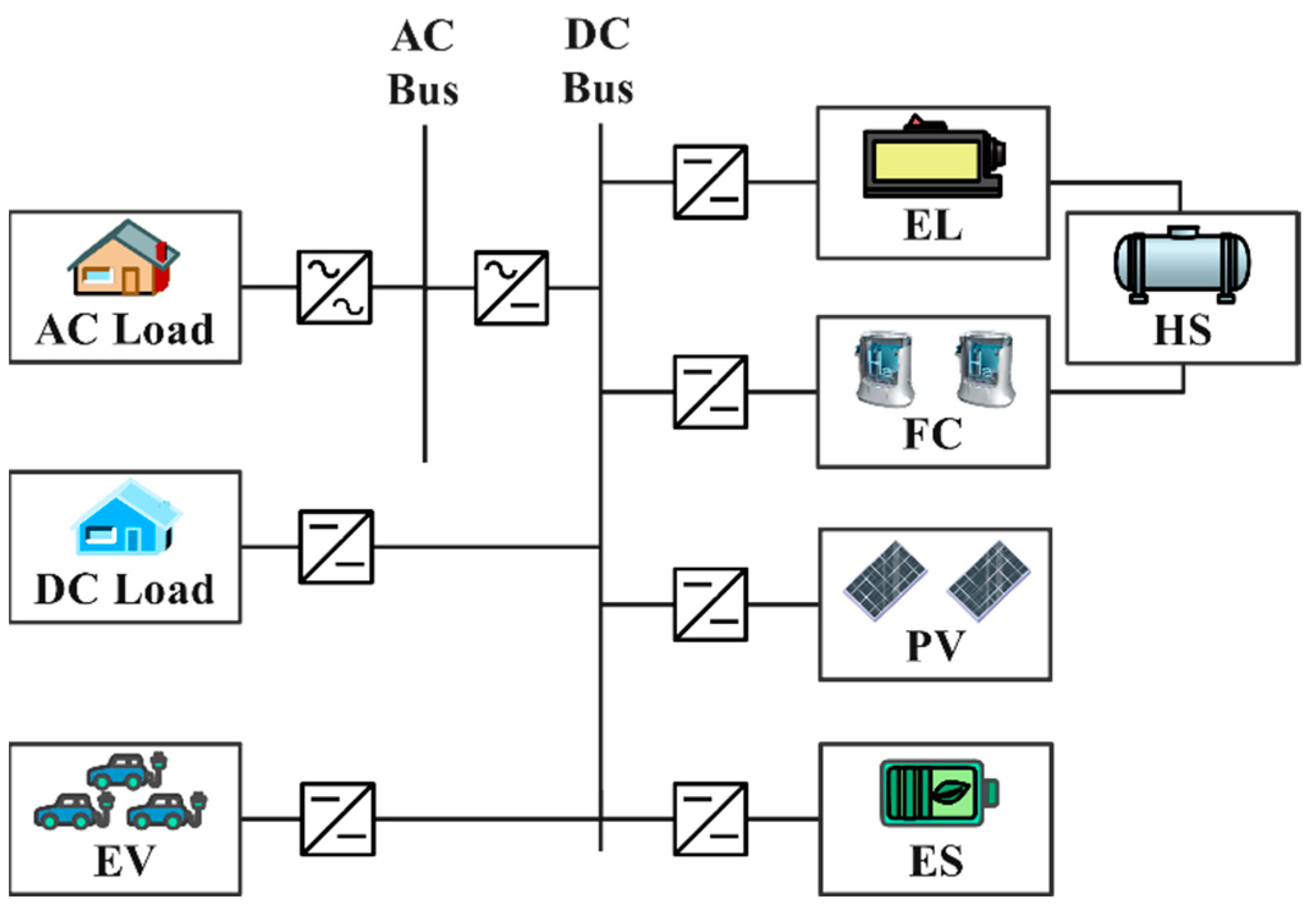
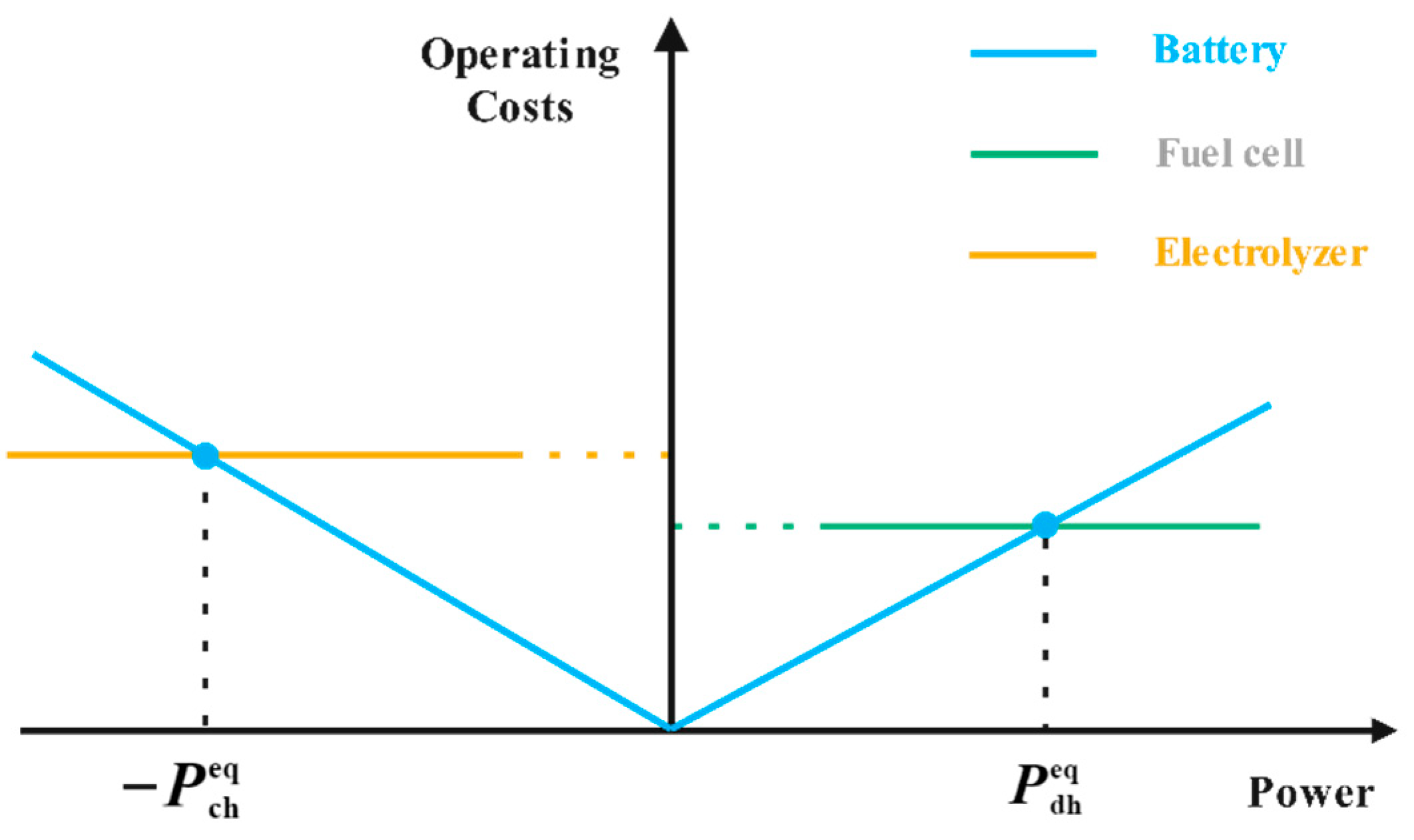
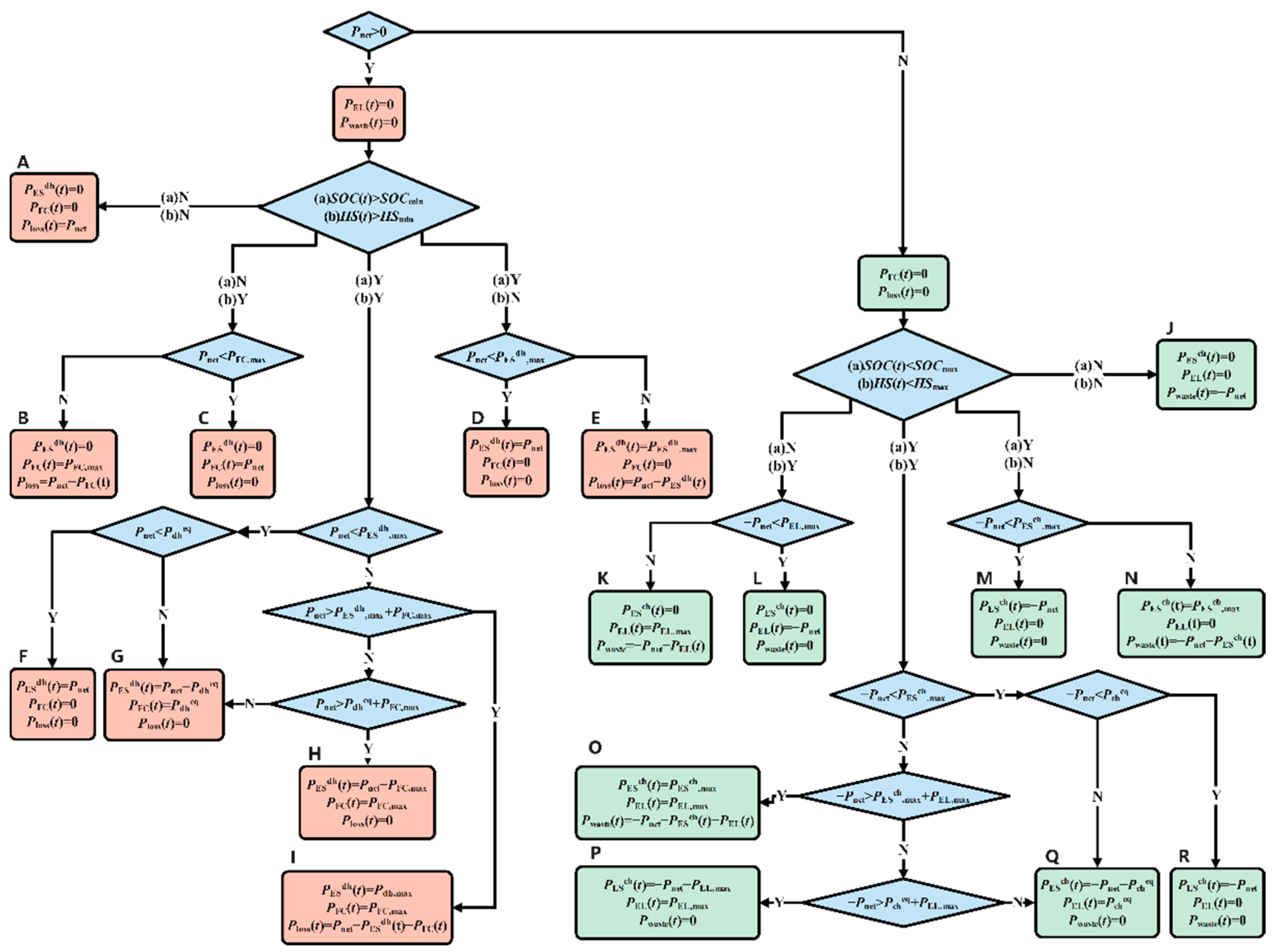
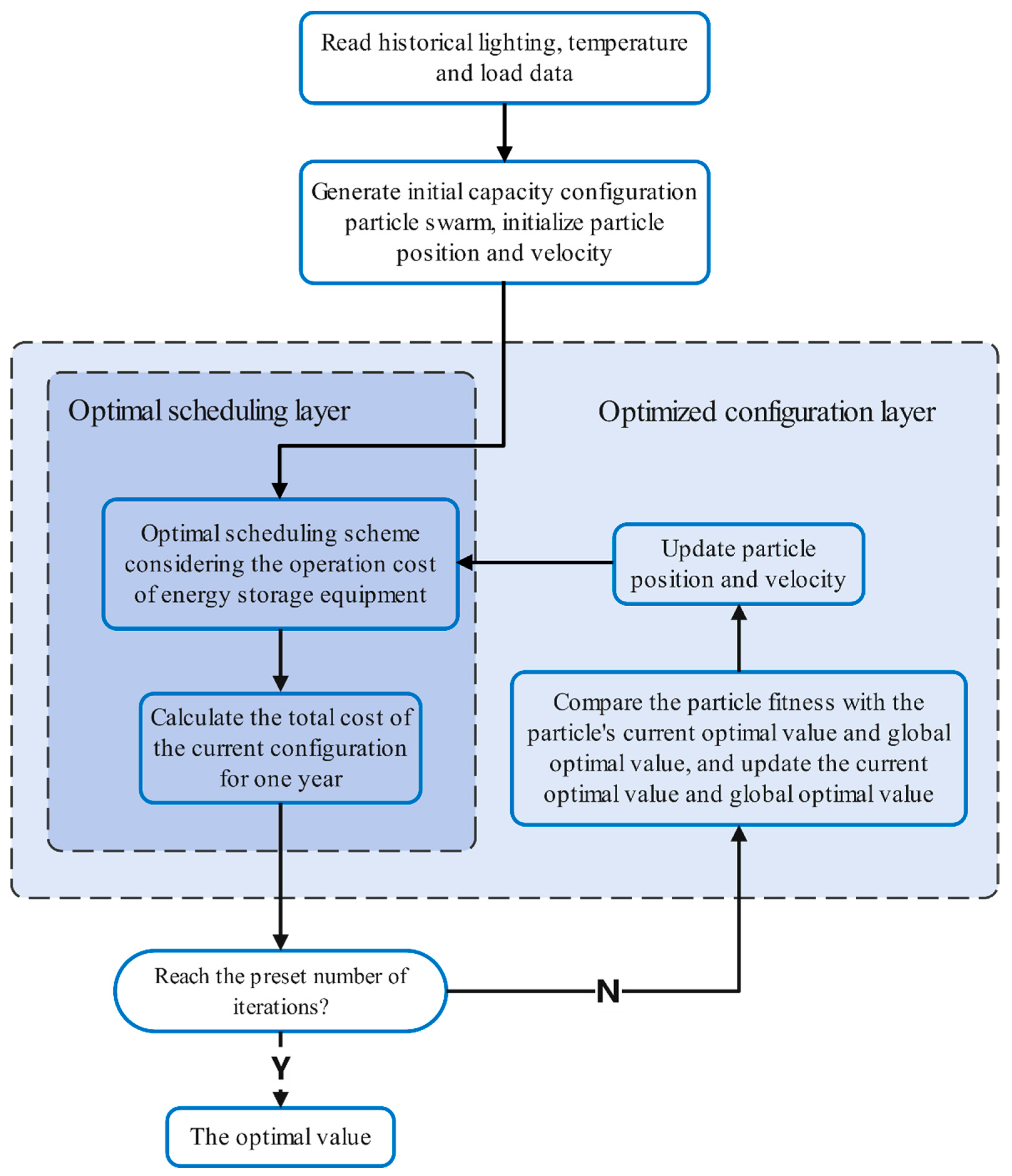



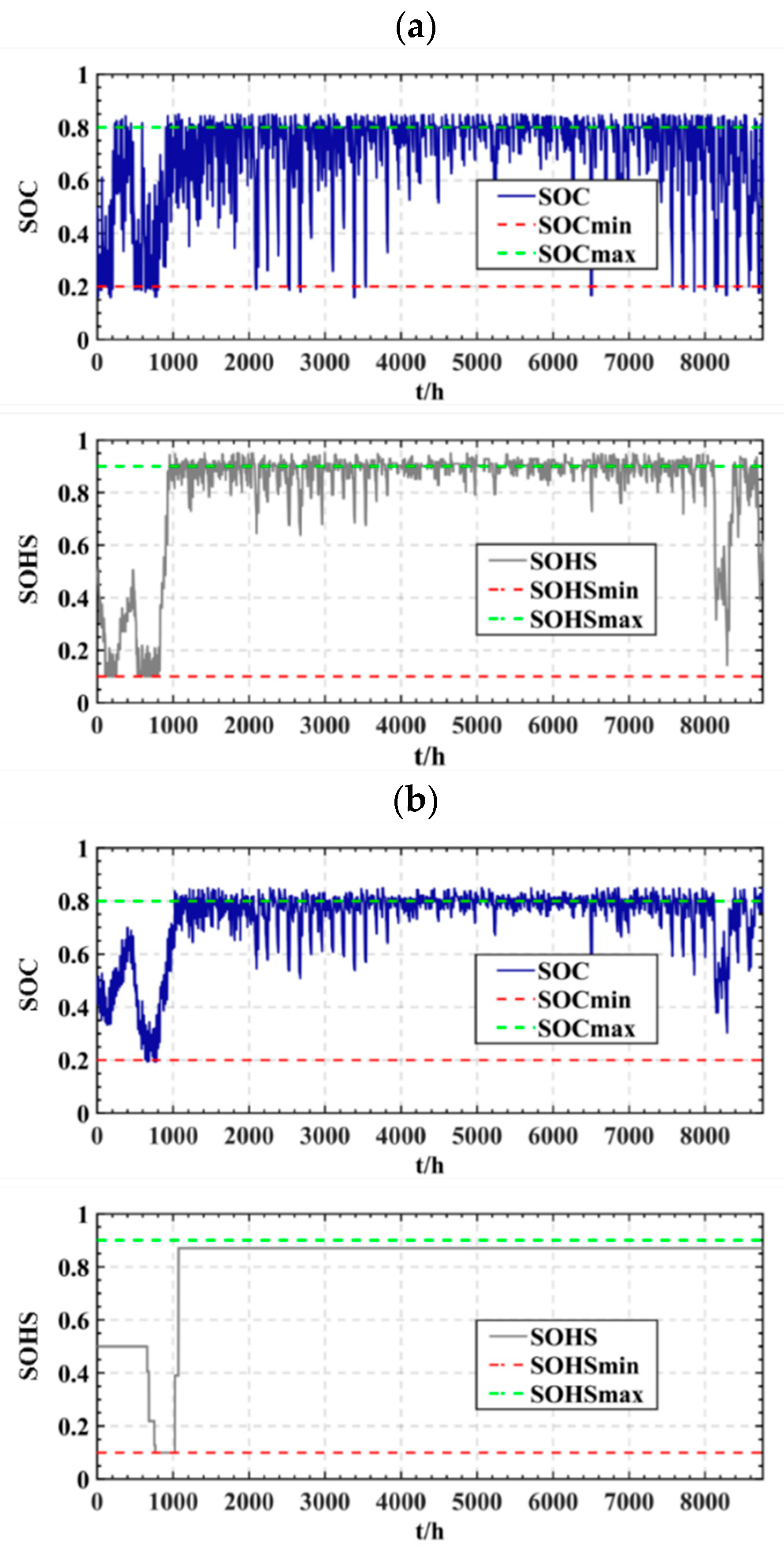
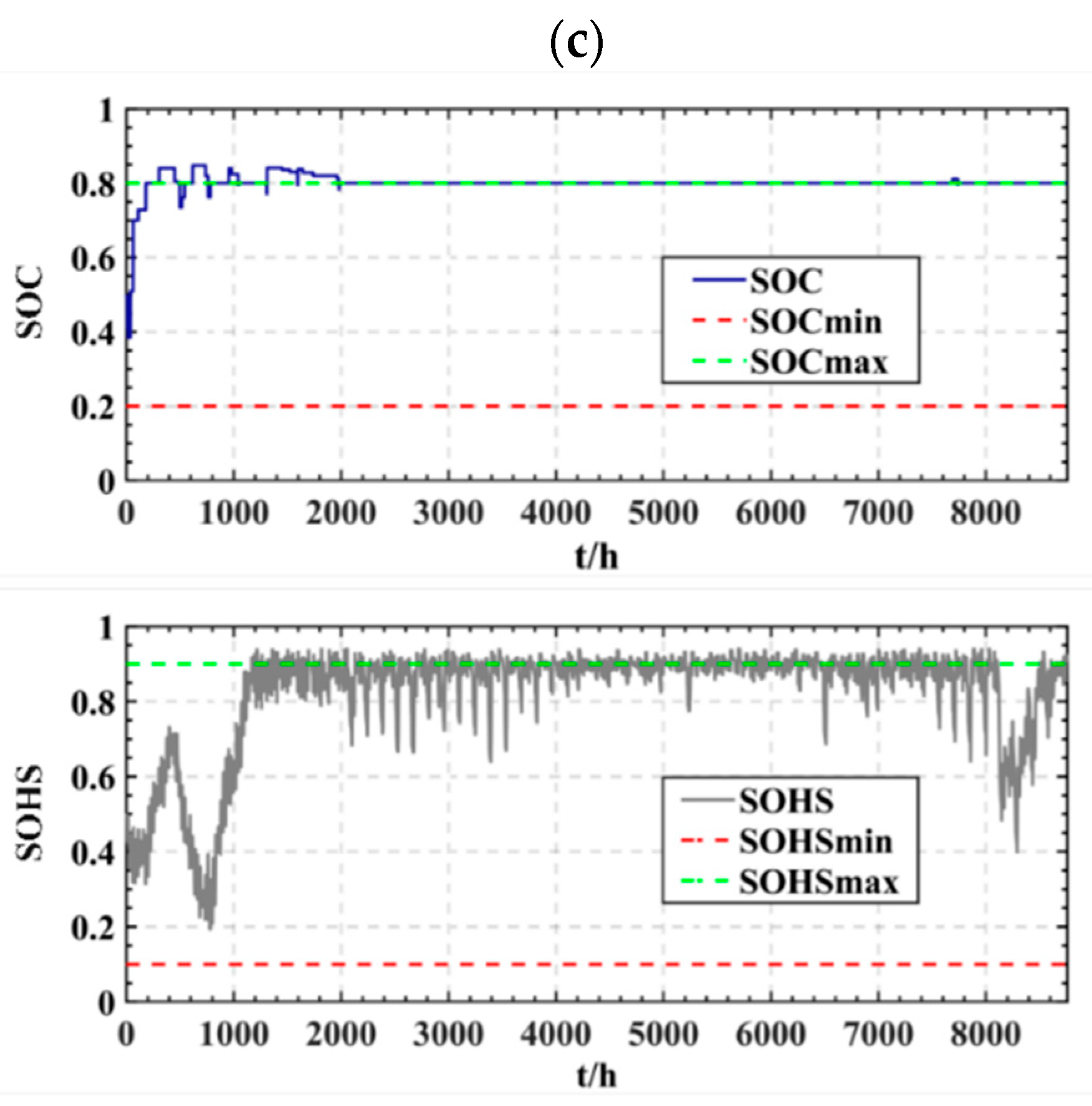
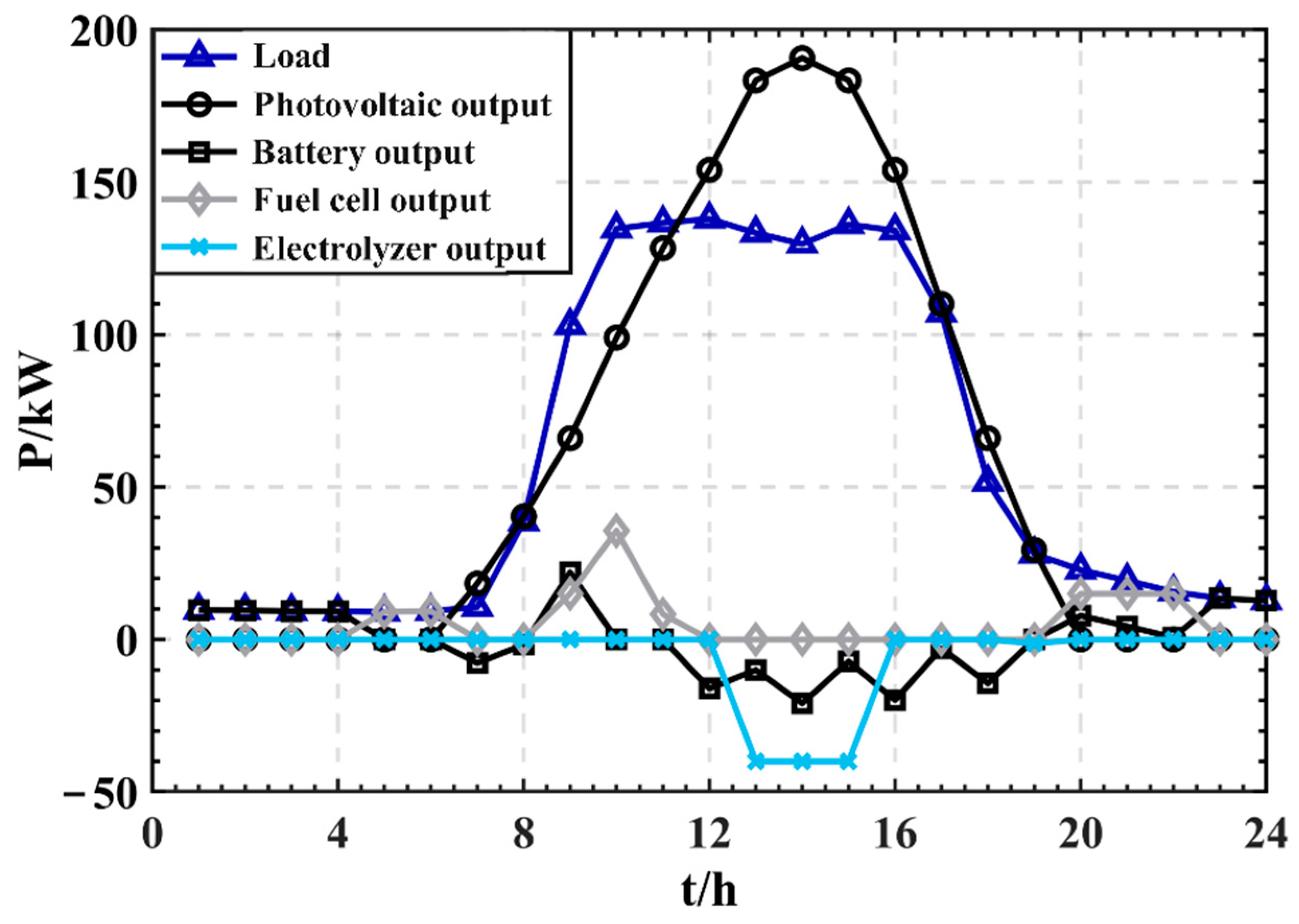
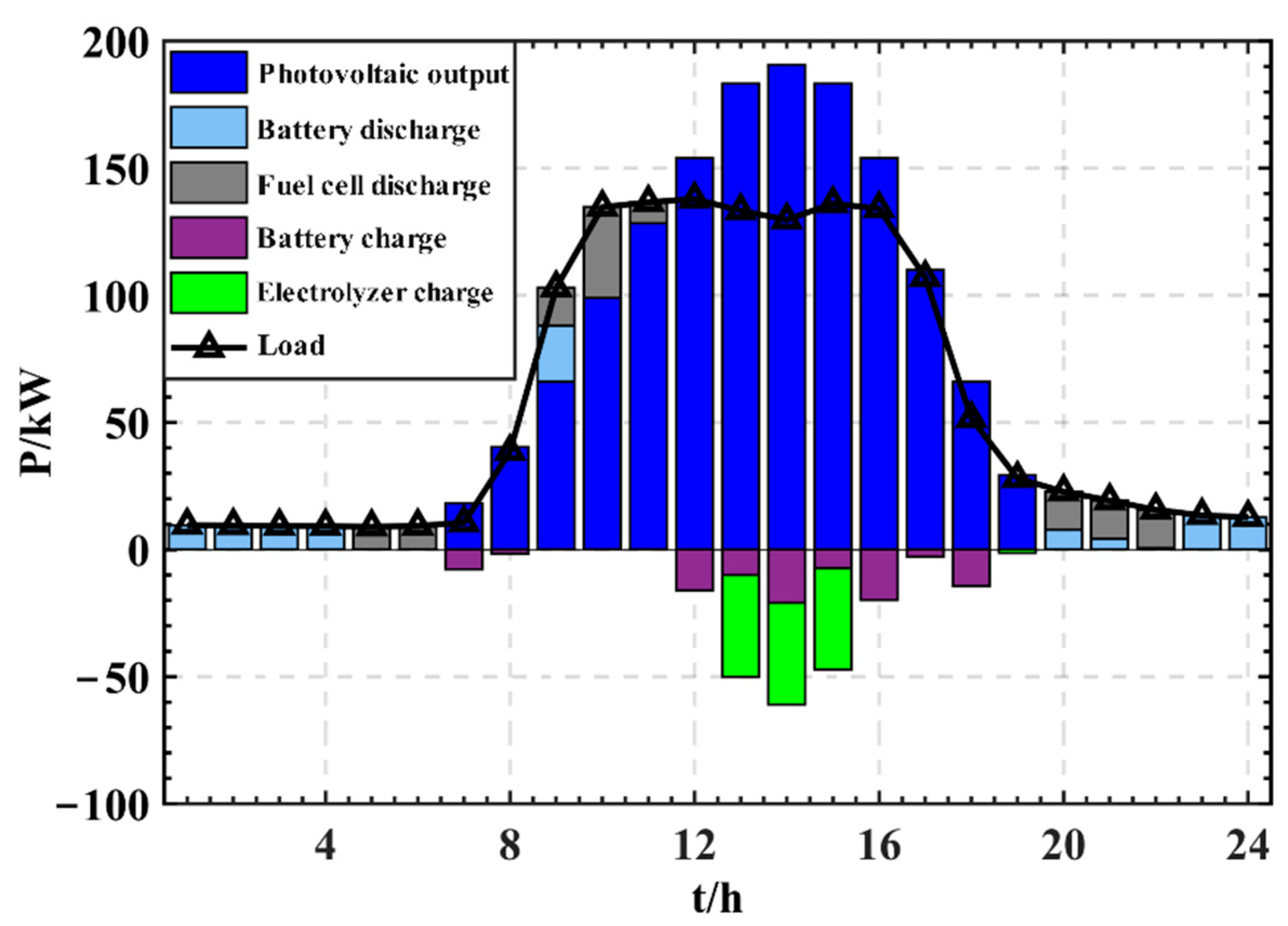
| Components | Parameter | Value |
|---|---|---|
| Photovoltaic | Unit purchase cost Unit operation and maintenance cost Life | USD 1140/kW USD 7/(kW·year−1) 20 years |
| Battery | Unit purchase cost Unit operation and maintenance cost Maximum number of cycles Charge/discharge efficiency | USD 110/kWh USD 1.2/(kW·year−1) 4000 0.95 |
| Fuel cell | Unit purchase cost Unit operation and maintenance cost Fuel cell startup cost Fuel cell shutdown cost Life Operating efficiency | USD 2400/kW [22] USD 48/(kW·year−1) [22] USD 0.002 3/kW [23] USD 0.001 6/kW [23] 30,000 h 60% |
| Electrolyzer | Unit purchase cost Unit operation and maintenance cost Electrolyzer startup cost Electrolyzer shutdown cost Life Operating efficiency | USD 1000/kW [22] USD 20/(kW·year−1) [22] USD 0.072 2/kW [23] USD 0.003 6/kW [23] 30,000 h 60% |
| Hydrogen storage tank | Unit purchase cost Unit operation and maintenance cost Life | USD 143/m3 USD 10/(m3·year−1) 20 years |
| Strategy | Scheduling Method | Installed Capacity | Total Cost ($/Year) | |||||||
|---|---|---|---|---|---|---|---|---|---|---|
| PV/kW ES/kWh FC/kW EL/kW HS/kWh | ||||||||||
| 1 | Scheduling strategy in this paper | 589 | 865 | 86 | 168 | 1540 | 0 | 68.1 | 100 | 189,896 |
| 2 | Battery priority scheduling strategy [17] | 618 | 3968 | 24 | 64 | 256 | 0.017 | 62.4 | 100 | 199,418 |
| 3 | Hydrogen energy system priority scheduling strategy [14] | 624 | 527 | 115 | 172 | 3782 | 0.026 | 59.3 | 100 | 240,300 |
Publisher’s Note: MDPI stays neutral with regard to jurisdictional claims in published maps and institutional affiliations. |
© 2022 by the authors. Licensee MDPI, Basel, Switzerland. This article is an open access article distributed under the terms and conditions of the Creative Commons Attribution (CC BY) license (https://creativecommons.org/licenses/by/4.0/).
Share and Cite
Zhao, H.; Xu, J.; Xu, K.; Sun, J.; Wang, Y. Optimal Allocation Method of Source and Storage Capacity of PV-Hydrogen Zero Carbon Emission Microgrid Considering the Usage Cost of Energy Storage Equipment. Energies 2022, 15, 4916. https://doi.org/10.3390/en15134916
Zhao H, Xu J, Xu K, Sun J, Wang Y. Optimal Allocation Method of Source and Storage Capacity of PV-Hydrogen Zero Carbon Emission Microgrid Considering the Usage Cost of Energy Storage Equipment. Energies. 2022; 15(13):4916. https://doi.org/10.3390/en15134916
Chicago/Turabian StyleZhao, Hongshan, Junyang Xu, Kunyu Xu, Jingjie Sun, and Yufeng Wang. 2022. "Optimal Allocation Method of Source and Storage Capacity of PV-Hydrogen Zero Carbon Emission Microgrid Considering the Usage Cost of Energy Storage Equipment" Energies 15, no. 13: 4916. https://doi.org/10.3390/en15134916
APA StyleZhao, H., Xu, J., Xu, K., Sun, J., & Wang, Y. (2022). Optimal Allocation Method of Source and Storage Capacity of PV-Hydrogen Zero Carbon Emission Microgrid Considering the Usage Cost of Energy Storage Equipment. Energies, 15(13), 4916. https://doi.org/10.3390/en15134916






